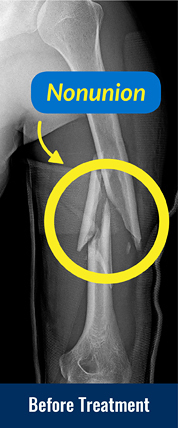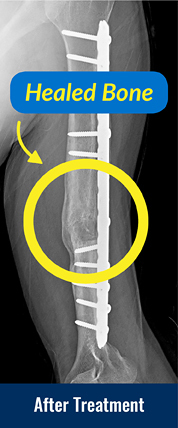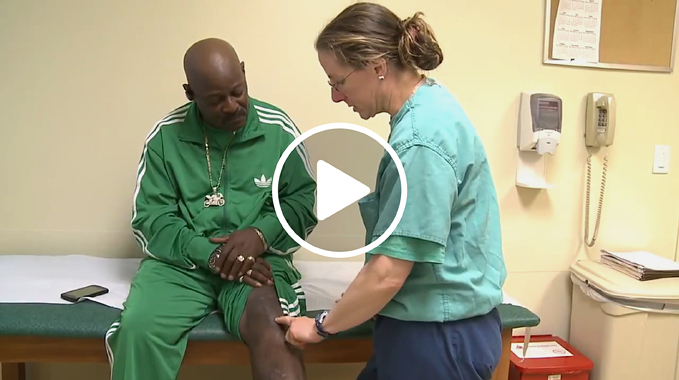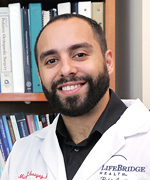Nonunion
What is a nonunion?
Bones that do not heal after fracture are called nonunions or pseudarthrosis. Nonunions occur when a bone that is broken, either from an osteotomy (surgical bone cut) or a traumatic event, fails to heal during the course of several months. Nonunions often occur when the fracture site has either too much motion or too little blood supply for healing. These nonunions often are associated with significant deformity, pain, swelling, difficulty with weight-bearing, leg length discrepancy and occasionally infection (osteomyelitis).
Pseudarthrosis means false joint, because the unhealed area of the bone has motion like a joint. These usually occur after trauma or surgery and mostly affect adults. A special kind of pseudarthrosis occurs in children without trauma; the bone fractures spontaneously. This is called congenital pseudarthrosis and occurs mostly in the tibia and forearm.
Video: Nonunions
Nonunions are bones that don’t heal. As one patient at the International Center for Limb Lengthening at the Rubin Institute for Advanced Orthopedics found out, it can be a painful, debilitating ordeal. But as you will see in this video, his nonunion was successfully treated thanks to the skill of orthopedic surgeon Dr. Janet Conway:
How are nonunions treated?
Nonunion treatment goals are to provide a stable environment for fracture healing, improve the bone healing biology of the fracture site, and correct any associated deformities. The treatment of nonunions related to fractures or surgery depends on many factors.
Infected Nonunion
If the nonunion is infected, it usually requires removing the dead infected bone and growing back healthy bone. This can be accomplished by acutely (all at once) shortening the limb to eliminate the bone defect and then lengthening the bone at a different site, as described for limb lengthening. Alternatively, we can use a special technique called bone transport where the defect is shortened at the same rate as the limb is lengthened, thereby not changing the length of the limb at any time. Both shortening with re-lengthening and bone transport result in a limb that is restored to equal length and normal alignment and that is solidly healed. It is sometimes necessary to insert a bone graft (the patient’s own bone) at the old nonunion site as part of these treatments. Bone grafts introduce new, healthy cells to stimulate growth.
Non-infected Nonunion
If the nonunion is not infected, it can be classified as either stiff or mobile and as hypertrophic (trying to heal) or atrophic (withering away of the bone ends). The mobility of the nonunion is assessed by examination of the bone and observing whether the unhealed area moves much in response to manipulation. This is a simple, painless test. If the unhealed area moves a lot, it is called mobile, whereas if it barely moves, it is called stiff. Based on radiographs, we classify nonunions regarding whether they show evidence of being hypertrophic by making new bone versus whether they show no evidence of bone healing and even show indications of atrophy. Usually, hypertrophic nonunions are stiff, and atrophic nonunions are mobile.
There are three types of treatment to consider: distraction of the nonunion, compression of the nonunion, and bone grafting of the nonunion.
- Distraction of the nonunion involves the application of an external fixator and gradual lengthening of the bone through the nonunion. This is a very successful treatment and has the advantage of not requiring any open surgery at the nonunion site; 90% of patients achieve union without the need for bone graft.
- Compression of the nonunion site (squeezing the bone ends together) is the other way to treat the hypertrophic stiff nonunion. It is also a good method for treatment of the hypertrophic mobile nonunion. Compression of the nonunion is achieved by the application of an external fixator or by means of internal fixation (plates, screws, and rods). Atrophic mobile nonunions usually require open treatment of the nonunion site, with removal of any dead bone and reshaping of the narrowed bone ends so that good bone contact can be achieved by compressing two horizontal surfaces. It is essential to add a bone graft to the nonunion site from cancellous bone (spongy, porous bone tissue) from one of the patient’s other bones.
- Bone grafting of the nonunion site can be combined with internal or external fixation. Bone grafting is usually avoided when there is active infection. It can be performed later as a separate procedure after the infection is eliminated.
Why choose the International Center for Limb Lengthening for treatment for a nonunion?
Your doctor at the International Center for Limb Lengthening will take the time to make sure you understand all your options and then will customize your treatment to meet your specific needs. Our patients benefit from our team-centered approach with world-renowned surgeons and specialized physician assistants, nurses and physical therapists. We help patients with nonunions achieve their best possible result.
Chat with a doctor about nonunions
Our doctors hold free monthly chats on various subjects, including nonunions. Click here for more information about our monthly chats.
Doctors who treat nonunions
*Patients Over 16 Years Old Only







